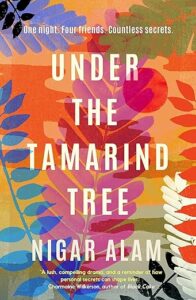Talking about locations in Under the Tamarind Tree -Nigar Alam
Talking about locations in Under the Tamarind Tree -Nigar Alam
This is a very special book. Can’t believe Nigar Alam is here in BookTrail Towers!!!

Indian tea and some wonderfully colourful sweets are on the table. Let’s tuck in!

Nigar Alam
For me, Under the Tamarind Tree could only be set in Karachi, Pakistan, because the story grew from a very personal place. Although it’s a work of fiction, I began researching and writing the book in order to learn more about my parents’ lives in their youth and about their families’ struggles during and after Partition.
Map of locations in Under the Tamarind Tree
As children, both my parents lived through the historical event of Partition, the chaos and violence, and the resulting mass migration — one of the largest in history. When my maternal grandparents crossed the border into Pakistan, they settled in Karachi where they raised their children in a house that remains in our family today. In fact, it’s what inspired my main character’s house in Under the Tamarind Tree.
Map of locations in Under the Tamarind Tree
I feel so fortunate to have lived with my grandmother in that house for several years. This setting is a big part of the book because the story follows the main character, Rozeena, and her three neighborhood friends who all grew up together on the same little road. It’s a fictional road in the book, but it’s based on my grandparents’ house and a road that I’ve walked on and lived on myself.
Map of locations in Under the Tamarind Tree
The book opens when the neighborhood friends are in their 20s navigating love, loss, and the rippling effects of the trauma of Partition. And the place around them is very much a character as well. It was important for me to have Karachi come alive for readers so they can see the city as more than a sensational headline in the newspaper.
Map of locations in Under the Tamarind Tree
My hope is that readers feel transported to Karachi. I hope that they’re immersed a different culture and society. We should all be able to see that regardless of geographical locations, people are the same everywhere — with the same hopes, fears, and joys. For this reason, Karachi was essential for the story but also for me personally. I was born there, and although I spent much of my childhood moving from country to country, I returned to the city and lived there as an adult for many years.
Map of locations in Under the Tamarind Tree
So when it came to writing about present-day Karachi, I used my lived experience. I still visit at least once a year. I know the place and culture and have watched the city transform into a megacity, with all the growing pains that come with it. Of course, I still had to research many other aspects, like gardening and the plants of Karachi since they play such an important role in the book.
Map of locations in Under the Tamarind Tree
I had to do more extensive research for the second timeline in Under the Tamarind Tree, the part of the story that’s set in 1964 Karachi. I dug through newspaper archives, documentaries, movies, photographs, and read fiction and nonfiction books. In addition, I also conducted interviews with people who lived and worked in Karachi during the 1960s.
Map of locations in Under the Tamarind Tree
I was lucky to be able to spend time speaking with people in medicine, law, and even the police. We chatted about how so many street names have changed over the years. Downtown Karachi has absorbed some of the suburbs. The sea has been reclaimed at places. Where there used be beaches and a coastline, brand-new neighborhoods are here to stay. Hearing personal stories of people who were young adults in the 1960s was one of the highlights of my research.

Map of locations in Under the Tamarind Tree
Finally, weaving in the historical event of Partition definitely required a lot of research. Although Partition takes place before my book even begins, the ripple effects are felt throughout the story. Amongst the the works I read was Yasmin Khan’s The Great Partition: The Making of India and Pakistan. I also read Vazira Fazila-Yacoobali Zamindar’s The Long Partition and the Making of Modern South Asia: Refugees, Boundaries, Histories.
I hopeUnder the Tamarind Tree allows readers to feel as if they’ve visited Karachi themselves, and that the sights and sounds and even aromas of the city come alive as they turn the page to discover the secrets of the past and the revelations in the present.
BookTrail Boarding Pass: Under the Tamarind Tree
Twitter :@NigarAlamWrites




